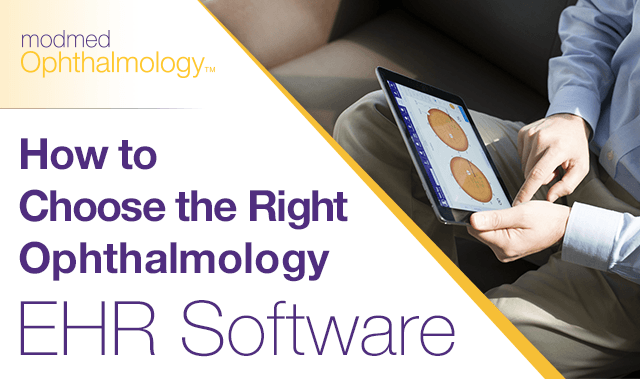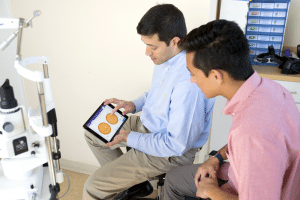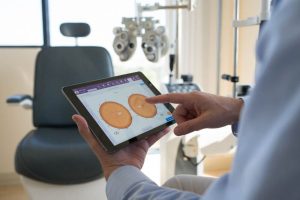How to Choose the Right Ophthalmology EHR Software

Choices. Life is filled with many of them. And when it comes to ophthalmology systems, there is no shortage of options out there. That being said, how do you know you’re making the right choice for your ophthalmology practice? In this post, I will help guide you to look at the big picture as well as seemingly small details that can make a big impact, and will help point you in the right direction when selecting your ophthalmology software for your practice.
I will share with you some of the reasons as to how and why you should invest in the right ophthalmology system. Whether you’re still using paper charts or are dissatisfied with your current EHR system, I will explain why ophthalmology software is needed and then dive into the process you can follow to help you select the option that is right for you.
Why You Should Invest in Ophthalmology Software & an EHR System
As a practicing ophthalmologist and one that also helps to code ophthalmology software myself, I am a big proponent of technology and more specifically using ophthalmology software which includes implementing an electronic health record (EHR) system in your practice.
Making such a change can certainly be filled with its share of challenges, but in the long run, investing in resources to help transition your practice to ophthalmology-specific software will benefit your ophthalmology practice clinically, operationally and financially.
From my experience, here are some of the reasons why you should purchase and invest in ophthalmology software and how you can make the right choice for you and your practice. The right technology will help reduce administrative burden, bring your focus back on treating your patients and help you feel more confident in getting paid what is deserved.
1. Time savings. Sifting through stacks of papers, trying to read often garbled handwriting and misplacing files or losing them to a flood or fire can all easily happen with paper charts. It’s just not an efficient or effective use of your valuable time, and we all know time is money. Technology should be a tool that helps add time back in your day.
While inputting data into an electronic medical record (EMR) system may appear to take more time than paper charts, that upfront time is more than made up for with automated coding, billing, MIPS/MACRA scoring, ability to remotely check charts and more.
Utilizing an ophthalmology-specific EHR system that is programmed by practicing ophthalmologists versus software developers, is iPad based versus desktop and is connected to the cloud versus a server can help add efficiency. A cloud-based, mobile and touch-based system makes for a much more efficient use of your time when it comes to documenting.
2. Increased Efficiencies. Simply put, technology should be designed to make you more efficient in your everyday life. Take your smartphone, DVR and car backup camera for example. Your EMR system should be no different. It should make documentation before, during and after an exam virtually effortless. Having an EMR system that remembers your preferences, such as what treatment or medication you routinely select to treat certain conditions, and allows you to tap and swipe your way on an iPad (versus writing or typing) through the exam, is something neither paper nor many legacy EMR systems are equipped to provide. Having access to the ophthalmology software technology that will automatically pre-populate your preferences and adapt to how your practice will make you more efficient in doing what you do best – treating patients. For increased efficiency, your EMR system should also allow for you and your technicians to work on the same chart simultaneously from different devices.
3. Accessibility and mobility. This is where both cloud-based software and iPad-based technology come into play. Cloud-based technology enables you to access patient data seamlessly and virtually from practically anywhere at any time, in addition to being able to have multiple users logged in simultaneously from multiple locations. You should be able to access medical records when you’re on the go all in the palm of your hand from your iPad, iPhone and maybe even on your Apple Watch.
4. Value-based care. I’m sure you’ve heard the news about the Medicare Access & Chip Reauthorization Act (MACRA) and The Merit-Based Incentive Payment System (MIPS), which is drastically changing healthcare reimbursement for physicians. Under these new government regulations, it is nearly impossible to capture the information needed to be financially reimbursed without the aid of ophthalmology software, specifically an EHR system. You need an EHR system that can capture structured data, provide adaptive learning and make submitting for MIPS as easy as possible. Be certain to ask the vendor questions on if they are ready for MIPS.
5. Data. With the right technology, the amount of data you should be able to access at your fingertips is exponential. Having access to such data can not only help your patients, but also help you compare things such as quality and cost against peers and focus on the health of your practice too. Data gives insights into the vitals of your patient and the vitals of your practice. Capturing data is going to be essential for successful reimbursement under MIPS and as the importance of interoperability increases as well. And when I reference data, I am specifically talking about structured, actionable data. This is data which should be captured in your EMR system at the point of care and will aid your practice in excelling clinically, operationally and financially, especially with the transition to value-based care and MIPS.
6. Patient engagement. If I could make an assumption, one of the reasons you probably became an ophthalmologist was to effectively treat and engage with your patients. Using paper charts or a desktop setup detracts from this doctor-patient experience. You either have to sit and write at your desk or turn and type – neither of which allows you to face the patient and focus on them. Advanced ophthalmology software should be able to run on an iPad where you can literally hold the patient’s medical record in the palm of your hand while tapping and swiping, all while facing your patients. With the transition to value-based care, the importance of patient engagement is certainly an area of increased focus.
effectively treat and engage with your patients. Using paper charts or a desktop setup detracts from this doctor-patient experience. You either have to sit and write at your desk or turn and type – neither of which allows you to face the patient and focus on them. Advanced ophthalmology software should be able to run on an iPad where you can literally hold the patient’s medical record in the palm of your hand while tapping and swiping, all while facing your patients. With the transition to value-based care, the importance of patient engagement is certainly an area of increased focus.
How to Choose Ophthalmology Software & an EHR System
So now you have reasons as to why ophthalmology software can enhance how you practice medicine in more ways than one. Now, here comes the time to make a decision on the EHR software that is right for your ophthalmology practice.
It’s important to take a step back and really understand the resources you need to invest in choosing ophthalmology software and the importance of asking the right questions along the way. As with any decision, it is one that should not be taken lightly. I hope that these action items, questions and tips help you in your ophthalmology software selection journey.
1. Evaluate your needs as a practice. Is a server or cloud-based system better for your practice? I would argue that using a cloud-based system will help you optimize your practice and poses many benefits compared to a more traditional, server-based model. How many providers and other users will need to use the system? Will a current staff person have the time and knowledge to help with the implementation process or will you have to consider hiring someone? How much training will your team need? In terms of additional services, what do you need from a software solution in terms of scheduling, billing, imaging, etc.? Knowing your practice’s answers to these questions ahead of time will help to best prepare you for the research and decision-making process that’s ahead.
In terms of selecting the right time to make a decision to move forward, this is something that you will have to determine for your practice. It’s one that is certainly not the same for everyone. Budget, resource availability and other office logistics can certainly influence the timing of moving forward with the selection and decision process.
What I can tell you is that from an industry perspective the time to make a change and migrate to the right ophthalmology software solution for your practice is now. The changing regulations with compliance and value-based care have definitely brought about the need for advanced technology particularly when it comes to your EHR system.
2. Is it specialty-specific? One size does not fit all, and using an EHR system designed for a family  physician,gastroenterologist or dermatologist is not going to fit your workflow as an ophthalmologist. You don’t want a generic, one-size-fits-all EHR system, but rather you want one that is ophthalmology-specific. One that has ophthalmic knowledge built in that’s available at your fingertips and learns your specific workflow and preferences as you go.
physician,gastroenterologist or dermatologist is not going to fit your workflow as an ophthalmologist. You don’t want a generic, one-size-fits-all EHR system, but rather you want one that is ophthalmology-specific. One that has ophthalmic knowledge built in that’s available at your fingertips and learns your specific workflow and preferences as you go.
3. Is it certified? Ensure the EHR vendor is ONC Certified HIT. The ONC-ATCBs test and certify that certain types of EHR technology are compliant with the standards, implementation specifications and certification criteria adopted by the U.S. Department of Health and Human Services (HHS) Secretary and meet the definition of “certified EHR technology.” Additionally, under the 21st Century Cures Act there are other certifications and guidelines vendors will have to meet otherwise they will be steeply fined. You certainly want to make sure the company you select is following proper procedures because if not, it could eventually have a negative impact on you as a provider.
4. How much does it cost? With all the options that are out there, a variety of price ranges exist as well. I have found that when it comes to ophthalmology software and technology in general, you get what you pay for. You have to know what you are willing to spend and have to know that it is a long-term investment that will benefit your practice’s health for years to come. It is one that often does not come at a bargain, but I can assure you that not utilizing the right ophthalmology software will cost you more (and not just financially) in the long run.
Think of it like your OCT or visual field machine. The cheapest may “work” but you may certainly prefer working with the best. Further, don’t get caught up in trying to spend more upfront to “own” software – with continual government mandates about what your EHR system has to do, you will find yourself soon outdated and paying a bundle to upgrade your software.
5. Do your research. Using a website like Software Advice or Technology Advice can help provide viable options based on your criteria and is a great resource to conduct some preliminary research. You can read through user reviews, compare various ophthalmology software platforms and talk to a third party representative who will send you recommendations and matches based on your criteria such as budget, features, number of providers, etc.
Black Book is yet another great resource to see how different EHR systems rank compared to others. The company provides qualitative insight into the industry’s top vendors through 18 key performance indicators, which are collected from a client submitted ballot. Over 540,000 EHR users were invited to participate in this year’s survey, and nearly 17,000 validated respondents shared their views. The gathered data is subjected immediately to an internal and external audit to verify completeness and accuracy and to ensure the respondent is valid while ensuring the anonymity of the client company is maintained.
is yet another great resource to see how different EHR systems rank compared to others. The company provides qualitative insight into the industry’s top vendors through 18 key performance indicators, which are collected from a client submitted ballot. Over 540,000 EHR users were invited to participate in this year’s survey, and nearly 17,000 validated respondents shared their views. The gathered data is subjected immediately to an internal and external audit to verify completeness and accuracy and to ensure the respondent is valid while ensuring the anonymity of the client company is maintained.
6. Learn about the company’s history. It’s important to get a glimpse into a company’s history, from how and who it was founded by to updates and enhancements to their software and other meaningful announcements along the way. Industry articles and company-issued press releases both serve as great historical information.
Both technology and healthcare are ever-changing industries and when you mix the two together, the changes are exponential. It’s important when evaluating ophthalmology software vendors that they exhibit a history of making improvements and changes that are based on client feedback and industry demands and are thinking and planning ahead for impending changes.
You want seek out an ophthalmology software vendor that can provide a track record of success – Black Book Survey and success rates add to a company’s credibility.
7. Find out about support options. Having a skilled team available and accessible to you, whether it be for online trainings, in-person visits or guidance on compliance, is important. Make sure the vendor you select offers robust support options and that they will be there every step of the way, even if it’s years down the road when additional help and guidance is needed. When it comes to ophthalmology software, as with all technology, updates occur often, difficulties can be encountered and things in the healthcare industry can rapidly change – you want to make sure you have access to experts who can help you along the way regardless of what stage of the process or experience you may or may not have.
8. Set up a demo & attend ophthalmology conferences. The old adage of “seeing is believing” is very true. It is one thing to read and hear about technology, but seeing it in action adds a whole new perspective. After you do your research, I encourage you to then take the time to further investigate the ophthalmology software that you were most interested in. Schedule demos (either web-based or in-person) with several vendors so you can compare pros and cons across the board and make an informed decision.
In addition to this, inquire about the upcoming conferences the company may be exhibiting at, and be sure to set time aside to meet some members of the team and see the product demoed in person as well.
9. Speak to & meet current users. Like what you saw and learned doing a demo? Take the next step. One of the best ways to fully understand how a product works is hearing directly from the source – current clients. Ask to speak to references and current users of the system. Have a phone conversation or, better yet, even visit an ophthalmology practice to see how the ophthalmology software works not just in theory, but in practice. Hearing directly from your peers will help to answer questions and even spark new ones.
Ultimately, there are numerous benefits to you, your practice and your patients when you employ the right ophthalmology software and specifically the right EHR system, and it is important to invest in the selection and decision-making process.